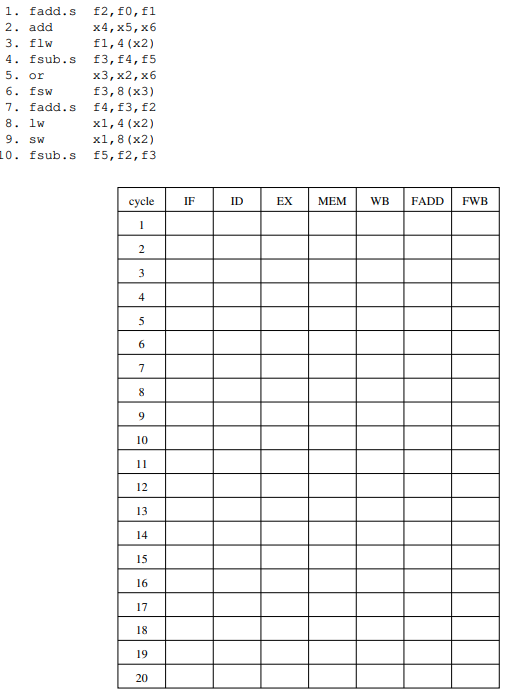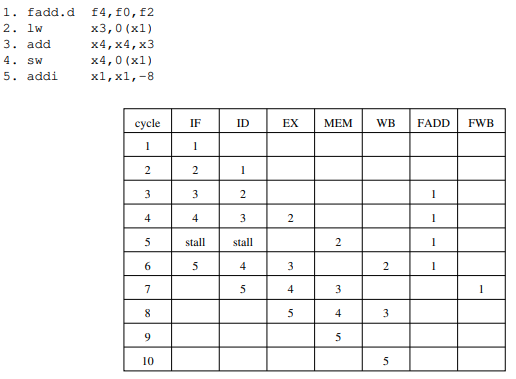Answered step by step
Verified Expert Solution
Question
1 Approved Answer
Help with detecting pipeline Hazards The image below is an example of how it is done Below is a sequence of RISC-V instructions. The pipeline
Help with detecting pipeline Hazards


The image below is an example of how it is done

Below is a sequence of RISC-V instructions. The pipeline diagram shows when each instruction will be in each stage of the pipeline. In this diagram, each row represents a cycle and each column represents a different pipeline stage. All instructions go through the IF and ID stages. Integer instructions go through the EX, MEM, and WB stages. Floating-point load instructions go through EX, MEM, and FWB stages. Floating-point add and subtract operations go through the FADD and FWB stages, do not go through MEM stage, and require 4 cycles during execution. Store instructions do not perform a write-back stage. 1. fadd.s f2,fo,fl 2. add 4,5,6 3. flw f1, 4(x2) 4. fsub.s f3,f4,f5 5. or 3,2,6 6. Isw f3, 8(x3) 7. fadd.s f4,f3,f2 8. Iw x1,4(x2) 9. SW x1,8(x2) L0. fsub.s f5,f2,f3 1. fadd.d f4,f0,f2 2. Iw x3,0(x1) 3. add 4,4,3 4. sw x4,0(x1) 5. addi 1,1,8 \begin{tabular}{|c|c|c|c|c|c|c|c|} \hline cycle & IF & ID & EX & MEM & WB & FADD & FWB \\ \hline 1 & 1 & & & & & & \\ \hline 2 & 2 & 1 & & & & & \\ \hline 3 & 3 & 2 & & & & 1 & \\ \hline 4 & 4 & 3 & 2 & & & 1 & \\ \hline 5 & stall & stall & & 2 & & 1 & \\ \hline 6 & 5 & 4 & 3 & & 2 & 1 & \\ \hline 7 & & 5 & 4 & 3 & & & 1 \\ \hline 8 & & & 5 & 4 & 3 & & \\ \hline 9 & & & & 5 & & & \\ \hline 10 & & & & & 5 & & \\ \hline \end{tabular}
Step by Step Solution
There are 3 Steps involved in it
Step: 1

Get Instant Access to Expert-Tailored Solutions
See step-by-step solutions with expert insights and AI powered tools for academic success
Step: 2

Step: 3

Ace Your Homework with AI
Get the answers you need in no time with our AI-driven, step-by-step assistance
Get Started


